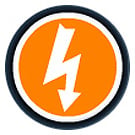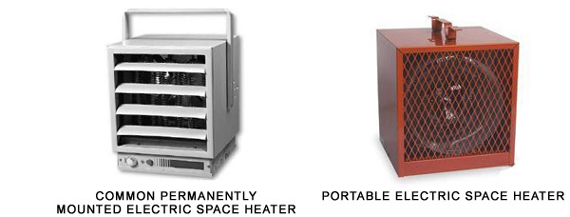Electric Garage Or Workshop Heater Buying Guide
Posted by NorthStock, Inc. on Dec 26th 2012

Electric Garage Or Workshop Heater Buying Guide
Fan Forced Electric Space Heaters for your Garage or Workshop.
Warming your garage or workshop can be conveniently accomplished using an electric heater. A fan forced electric space heater is inexpensive to buy, easy to operate, maintenance free, and able to heat areas where other heating solutions might be difficult to install, expensive, or impractical.
Operating Principle:
An electric heater converts electrical energy into heat. The heating element inside every electric heater is an electrical resistor which works on the principle of Joule heating: electric current flowing through a resistor converts electrical energy into heat energy.
Air is moved past the heating element by an electric fan. This reduces the thermal resistance between the heating element and the air, allowing heat to be transferred more quickly. The hot air leaves the heater and warms the surrounding area. Heating of a room occurs rapidly, however operation may be noisy.
Common Permanently Mounted Electric Space Heater

Benefits of a fan forced electric heater in garages or workshops:
• Simple thermostat control.
• Clean heat, no odor, no by-products of combustion.
• Quick heating of enclosed spaces.
• No open flame to worry about.
• High temperature cut-out turns the heater off if it gets too hot.
• No messy fuel oil or dangerous natural gas to contend with.
• 100% Efficient.
• No maintenance.
• Very reliable. The only moving part is the easily replaceable motor and fan assembly.
• Louvers direct warm air where you need it most (available on select models).
• Durable. Casing is treated for corrosion resistance.
• Compact and lightweight
• Fast, easy installation.
• Versatile mounting bracket allows attachment to wall and/or ceiling (available on select models).
• Wide range of sizes available to match your heating load.
• Fan only can run in the Summer to help circulate air (available on select models).
Things to consider with a fan forced electric heater in garages or workshops:
• Manufacturer’s recommended clearances from walls, ceilings, and combustible materials must be maintained.
• Must never be used when flammable gases or particles are present in the air.
• Will not operate during a power failure.
• Sound created by fan.
• The circuit feeding the heater must be sufficient to carry the amperage (electricity flow) the heater requires.
• Heater moves air which can kick up dust in your garage or workshop.
• Fan speed can not be adjusted.
Unit Configurations:
Electric space heaters are available in hard wired permanently installed or plug-in portable configurations. A permanently installed heater mounts out of the way on a wall or ceiling, while a portable heater is plugged in (special receptacle is usually required) where heat is needed and placed on a hard, level surface.
Installation Overview:
1) Suspend the space heater using the mounting bracket or place on a hard surface. Maintain suggested clearances from walls, ceilings, and combustible materials.
2) Wire power to the heater or plug it in (special power receptacle is usually required).
Commonly Asked Questions:
1) How efficient is an electric garage heater?
ANSWER: Electric heat is 100% efficient because all the electricity used is converted to heat. However, the fossil fuel power plants that generate most electricity are typically only 30 to 40 percent efficient. Thus even with a 100% efficient electric heater, the amount of fuel needed for a given amount of heat is much more than if the fuel was burned in a furnace or boiler at the building being heated instead of being turned into electricity and then turned into heat.
2) How do I calculate the heating load for my garage or workshop?
ANSWER: Call us or use our simple heat load calculator. Do NOT fall for equipment that is advertised as “will heat up to 400 square feet”. Heating a 400 square foot insulated garage in Florida is a lot different then heating a 400 square foot uninsulated metal garage in Maine. We are happy to run a detailed engineering calculation that will help you pick the perfect heater for your space.
3) How do I control an electric space heater?
ANSWER: A thermostat cycles the heater to maintain the desired temperature. Most electric space heaters have built-in thermostats. If not, you’ll need to install a wall or unit mounted thermostat to tell the heater when to run.
4) What is the best location in my garage or workshop to install my electric unit heater?
ANSWER: The electric heater in your garage or workshop should be located in the coldest area, and it should be angled slightly so it blankets warm air across the coldest wall.
5) What clearances must be maintained?
ANSWER: Requirements vary depending on the heater, call us or check your heater’s installation instructions.
6) What is the best location to install a thermostat in my garage or workshop?
ANSWER: A well insulated interior wall is the best place for the thermostat.
If it is located in a cold spot, it will run the heater more then it should. If it is located in an area that receives warm direct sunlight, it will run the heater less then it should.
7) What kind of sound can I expect from an electric heater?
ANSWER: While sound is created anytime fans and motors are used to move air, unit heaters are designed to minimize their sound level through the careful selection of motors, fan blades and the design of the air intake opening. Sound is comparable to a box window fan.